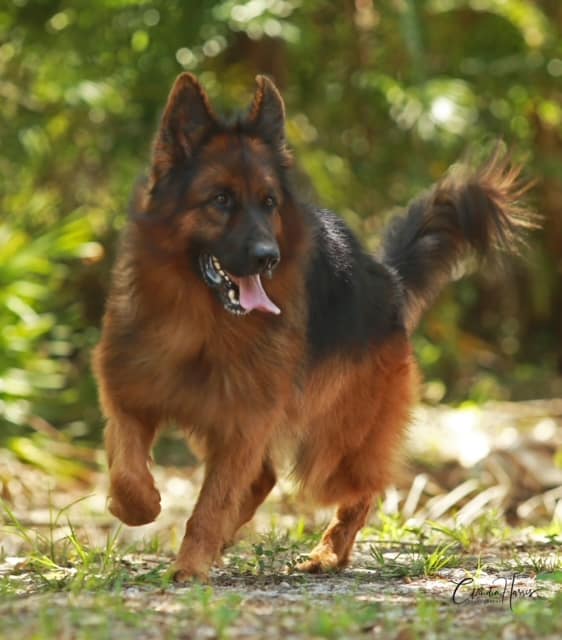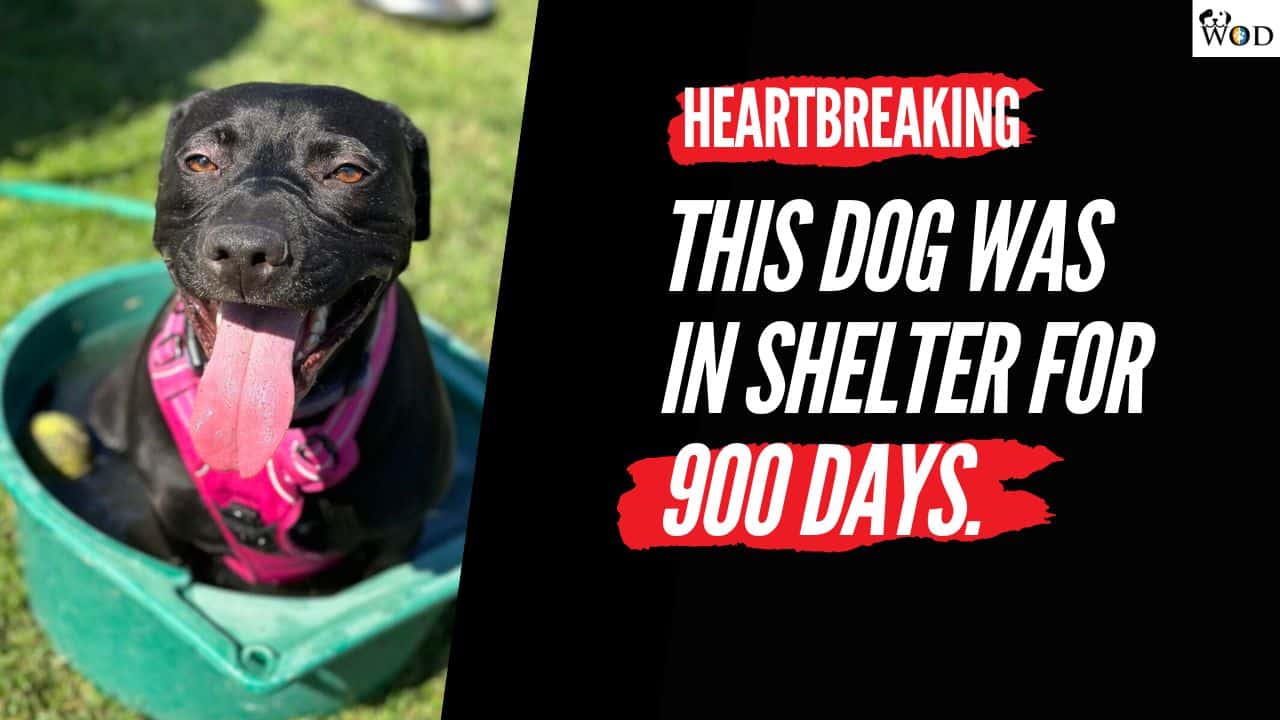When you become interested in getting a German Shepherd, you realize that the task of simply acquiring one is tougher than it seems. You have to pick the right coat type, color, and pattern: factors most outsiders don’t even know exist. Here’s what they mean.
- German Shepherd Coat Type – This refers to the dog’s coat length and quantity. This is mainly divided into lengths: short-haired, medium-haired, and long-haired, and in quantity: single coat and double coat.
- German Shepherd Coat Color – This describes the color of a German Shepherd’s topcoat. It is significant because some colors dictate price, and others are indicative of the dog’s chances of entering or winning a dog show.
- German Shepherd Coat Pattern – The term refers to how the color of a German Shepherd’s topcoat is distributed. Since German Shepherds are rarely a solid color, they almost always have a patterned top coat. It also includes facial patterns.
In this article, I will briefly cover each of the above so you have a decent idea about the variations. That way, when you go to your local breeder, you will understand the lingo and will be able to articulate what you truly want when getting a German Shepherd.
More importantly, you’ll find a trait to fall in love with and read more about because this article includes links to dedicated posts on different coat types, their colors, patterns, and care. So, let’s get started with the coat lengths.
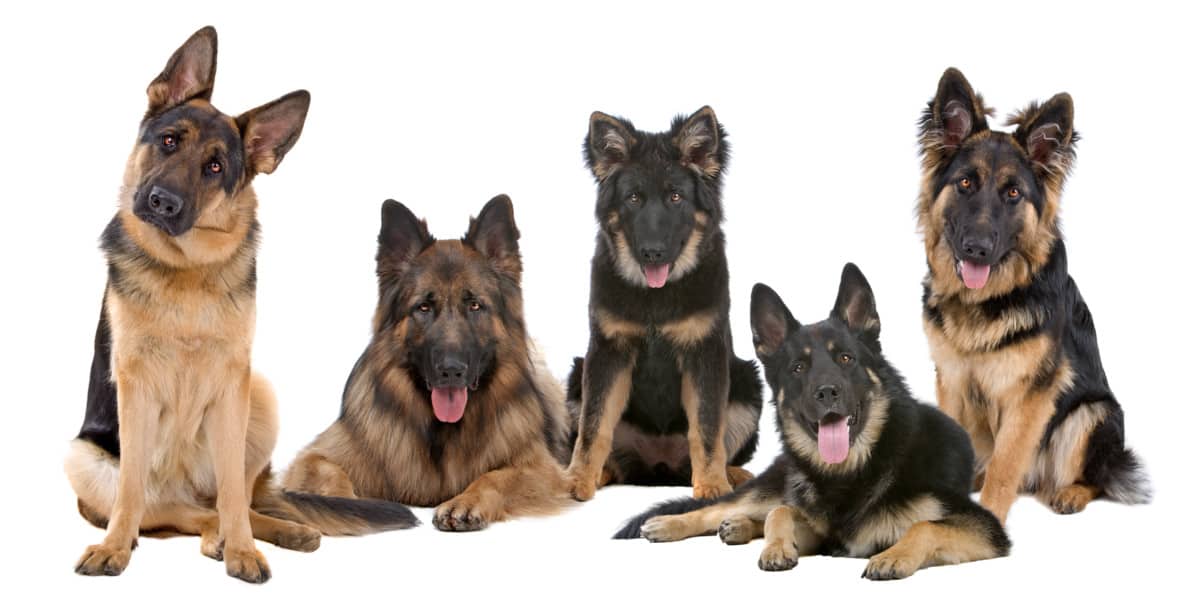
German Shepherd Coat Types
| Short-haired German Shepherd | Medium-haired German Shepherd | Long-haired German Shepherd |
| Hair is close to the body | Hair is slightly longer than short coat | Hair is longer and thicker |
| Minimal feathering on legs and tail | Feathering on legs and tail | Feathering on legs and tail is more pronounced |
| Easier to maintain and groom | Can be more prone to matting and tangling | Requires more grooming and maintenance |
| Shedding can be more noticeable | Shedding can be moderate | Shedding can be heavy |
Check Out Our YouTube Video on German Shepherd Coat Type Lengths…
Short-Haired German Shepherd
Short-haired German Shepherds comprise most of the modern breed because their short topcoats are functional and abundant. They also have undercoats, which assist in temperature regulation and protect the dog’s skin from exposure to the elements.
They shed continually throughout the year, albeit at a varying rate as the amount of fur shed by the undercoat is heavier during the fall and spring seasons.
Short-coated German Shepherds have a short, dense topcoat (guard coat) with straight, coarse hair which lies close to the dog’s body. The fur around the neck is slightly longer and thicker, and they have marginally longer hair on the rear of the hind legs to the hock and the rear of the forelegs.
It isn’t uncommon for the term “short-haired German Shepherd” to be replaced by “German Shepherd,” given that the long-haired variety is rarer. This type is a safer purchase for anyone unsure about the show circuit. They are also the preferred choice as working dogs.
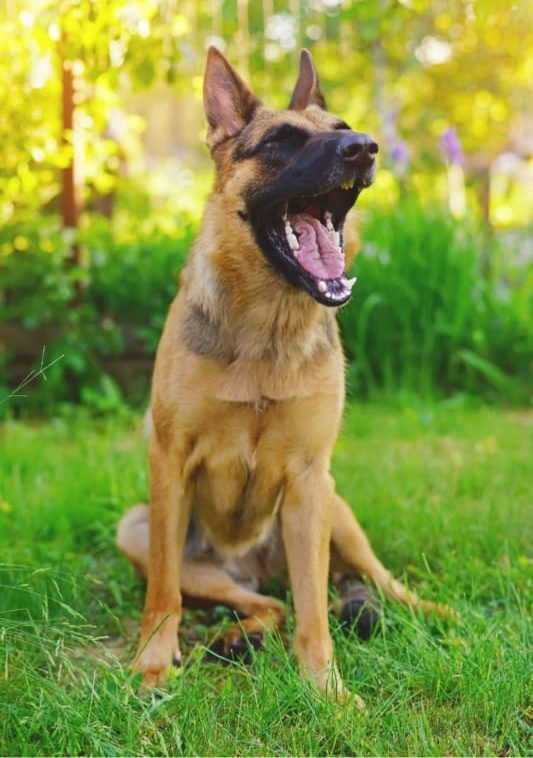
If there’s even a small chance you might enroll your dog in a show, you should go for the short-haired type. Medium-haired varieties qualify for shows as well but can be more expensive.
Provided short-haired German Shepherds’ prominence and “safeness,” it is understandable that this coat type is taken as the breed’s default hair length. Generally, a short-haired dog’s topcoat will feature hair no longer than an inch long.
The type at a glance:
- Has a double coat and a topcoat with 1 inch or shorter hair.
- Most common coat type.
- Often used in working roles such as police, military, search and rescue, and service dogs.
- Commands a medium-to-high price.
- Can enter dog shows depending on color acceptability.
Short-Haired German Shepherd Coat Care
To take care of a short-haired German Shepherd’s coat, you must groom him fairly regularly. This entails brushing him two to three times a week. This will help remove loose fur trapped in his coat and simultaneously form a mutual appreciation bond.
Brushing and de-shedding will need to increase to three to four times a week in the spring and fall seasons because the undercoat shedding increases. This is when your dog will “blow” his coat.
Read More: German Shepherd Shedding: Causes, Season and Solutions
I use the FURminator undercoat de-shedding tool from Amazon. I like it because it reaches safely through the topcoat and removes the loose undercoat with ease. I’ve tried many grooming tools over the years, but I’ve never found anything as good as the FURminator.
You don’t need to bathe your GSD often. Generally, a German Shepherd needs no more than two to three baths a year.
Medium Hair (Plush Coat) German Shepherd
Medium-haired German Shepherds are also referred to as plush coats because of their coats’ plushness. They have a fuller look, and they combine the most desirable traits of both the short-haired and long-haired types. Longer topcoat fur makes a dog look aesthetic. My German Shepherd is medium-coated, as you can see in the below photo.
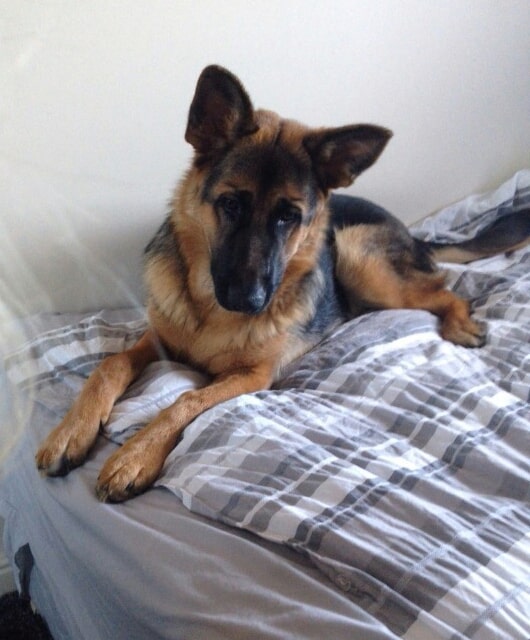
Plush coats have a topcoat length somewhere in between the short and long-coated varieties. They also have an undercoat which allows them to take their beautiful appearance to dog shows. On average, a medium-coat German Shepherd has a topcoat length between 1 and 2 inches.
This coat type will raise the German Shepherd’s price, so if you’re getting one, you should do so with a rationale. Since the greatest driver of the medium-haired dog price-hike is his ability to get into and win dog shows, you should pay extra only if you want to enroll him in one.
Having said that, many owners, including myself, will purchase a medium-haired German Shepherd having no intention of showing. They appreciate the look and temperament of this type.
The type at a glance:
- Has a double coat and a topcoat with 1 to 2-inch hair.
- Coat type is not common but not uncommon either.
- Commands premium price, especially if they have a qualifying color.
- Can enter dog shows depending on color acceptability.
- Also used in various working roles such as law enforcement and service dogs.
Medium-Haired German Shepherd Coat Care
A medium-haired German Shepherd has more hair volume given the undercoat and a slightly longer topcoat. However, they will also require regular brushing. Again two to three times a week is a good practice.
Shedding in plush-coated dogs also increases in the fall and spring when they shed their undercoat ready for the new season ahead. Regular brushing also fluffs up the coat for the best appearance.
Before using the de-shedding tool mentioned above, I use the FURminator grooming rake, also from Amazon. This is better for thicker fur, such as the plush coat, and I use it for extra undercoat care. The rotating rounded metal teeth make a huge difference, especially if your doggo doesn’t like brushing.
Medium coats should also be bathed 2-3 times per year as over bathing will dry their skin and remove natural oils.
Long-Haired German Shepherd
Long-haired German Shepherds have the longest hair across all coat types. However, their undercoat is often missing, which makes them unfit for AKC conformation events. When this occurs, we refer to them as being “open coated.”
Long-coated German Shepherds have a long, soft topcoat that does not sit close to the body. The hair is often shiny and may form a parting along the back. Feathering occurs on the ears and legs, and they will have longer and thicker fur around the neck, which looks like a mane.
On average, the topcoat features hair of at least 2 inches in length. However, grooming doesn’t require clipping their hair. In fact, in many instances, their missing undercoat requires a longer topcoat cover for temperature regulation.
Long-haired varieties are considered objectively beautiful. However, their absent undercoat disqualifies them from a competition where said beauty would be rewarded.
Getting a long-haired German Shepherd can be a wise investment for someone who wants a beautiful dog but doesn’t care to get recognition for his pet’s beauty in the form of a trophy.
Because the long-haired variety cannot usually enter conformation, you can buy one much cheaper than a short or medium-coated dog.
The type at a glance
- Usually has a single/topcoat with 2-inch hair.
- The least common coat type.
- Usually commands a lower price.
- Cannot enter a dog show unless double-coated.
- Friendlier temperament due to lack of working drive.
Long-Haired German Shepherd Coat Care
Long-haired German Shepherds need a grooming regiment noticeably different from standard types. Shedding is consistent throughout the year in single-coated dogs, without the massive increases in the fall and spring.
You will still need to brush them frequently to prevent knots and tangles in the long fur. I recommend a good slicker brush, such as the Hertzko self-cleaning brush from Amazon.
This brush is excellent for getting rid of tangles and knots without hurting your doggo, as the fine bristles do not scratch. They also retract back into the brush to avoid getting damaged when not in use.
Read More: Long Haired GSD vs. Short Hair: What’s the Difference?
Looking at the appearance of long-coated GSDs, one would assume they require a lot of washing. That’s the opposite of the truth.
The lack of an undercoat makes it too risky to wet the topcoat as the dog can get cold. That’s why three baths a year are more than enough for this variety.
Double Coated or Single Coated?
German Shepherd Double Coat
A double coat is the preferred type among German Shepherds as per the American Kennel Club standards for the breed. It is also closer to the dog’s wolf ancestors. Over 90% of the breed has two coats, both of which undergo high shedding.
The only German Shepherds with a missing undercoat are the long-haired ones. In some rare instances, a short-haired German Shepherd might have a very thin undercoat and might be disqualified from the show ring for the same reason. Such a dog isn’t a standard double coat.
Whether you’re getting a German Shepherd for work or show, you should check with the breeder if the dog has a double coat, especially if you are raising it to stay outside regularly.
You can afford to have a single-coated pet if you live in a warmer climate. With the absence of an undercoat, they are more vulnerable to extreme temperatures.
Single Coat (Open Coat) Confusion and Controversy
Sometimes a breeder might tell you that the German Shepherd has two coats and is “open coated.” As far as the AKC is concerned, such a dog has only the topcoat, which means he cannot enter a conformation event.
Having an open coat doesn’t affect the dog’s health, and if you want a German Shepherd as a pet only, the single coat shouldn’t discourage you. That said, you should not pay a premium price for an open coat since such a coat type is considered a fault.
Open Coat at a Glance
- Technically has an undercoat; however, it is practically non-existent as it is extremely thin.
- Cannot enter dog shows.
- It is considered a fault, the same as a single coat by the AKC.
- Should cost less than the average German Shepherd.
Things To Keep In Mind When Getting an Open Coat GSD
Shedding and Allergies
Because your German Shepherd doesn’t have much of an undercoat, the hair he sheds will be finer. This is further complicated if the dog is a lighter color and the hair isn’t clearly visible. German Shepherds aren’t hypoallergenic, and even the open coated dogs having the thinnest of undercoat hair can trigger an allergic reaction in almost anyone with particle or pollen allergies.
Temperature Regulation
Open-coat German Shepherds with longer topcoats are simply called single-coated. If your dog has an open coat, he is vulnerable to the elements. Making sure your dog is sufficiently protected from the cold and heat is one of your key responsibilities.
“You should not keep single-coated German Shepherds as outside or working dogs.”
German Shepherd Coat Colors
Standard German Shepherd Colors
If you head to your local breeder armed with the knowledge above, you still might end up getting a German Shepherd unfit for show or one with recessive traits. It is crucial to know about all the German Shepherd colors so you know you’re paying the right price for the dog you’re getting.
Below you can see all the German Shepherd coat colors and whether they are standard, rare, and/or seen as a fault by the American Kennel Club.
| GSD Color | Standard, Rare, or AKC Fault |
|---|---|
| Black and Tan | Standard |
| Black and Red | Standard |
| Black and Silver | Standard |
| Black and Cream | Standard |
| Black | Standard |
| Bi-color | Standard |
| Sable | Standard |
| Gray | Rare |
| Isabella | Rare / AKC Fault |
| Blue (inc Blue and Tan) | Rare / AKC Fault |
| Liver (inc Liver and Tan) | Rare / AKC Fault |
| White | Rare / AKC Fault |
| Pale or Washed-out Colors | AKC Fault |
Even if you don’t want to remember the 21 colors and patterns of German Shepherds, knowing the standard colors can help you decide what kind of a doggo you wish to get.
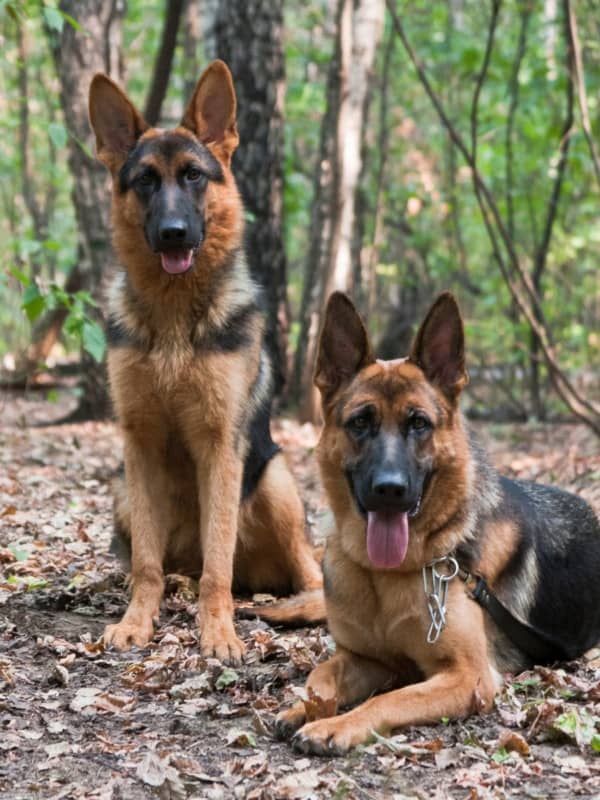
The typical German Shepherd colors are black, tan, and red. They are usually a combination of:
- Black and tan
- Black and red
- Black and cream
- Black and silver
Black German Shepherds, sable, and bi-color also make up this category.
Lighter colors disqualify a dog from the show ring, whereas richer shades win shows. That’s why it is essential to read up on the colors and their implications on a German Shepherd’s shot at the show ring.
The colors mean a great deal in the show line German Shepherds, and if a rare color is also a fault, then the price doesn’t skyrocket. However, a fault isn’t considered a big deal in the working lines, and rarer colors can still command a high price.
When buying a German Shepherd, you must ask to meet the parents and check their health screening so you get the healthiest dog regardless of which color you get.
Rare German Shepherd Colors
Specific genetic mutations change the common color shades of black, red, or tan to the point of changing the dogs’ entire look.
However, because these looks don’t win prizes and dogs are often disqualified from pageants, breeders don’t aim to get more puppies of similar looks.
And even when certain breeders try to breed puppies with exotic colors, the fact that recessive genes dictate said colors decreases the odds of having a rare colored puppy. Consequently, colors outside of black, tan, and red are rare to varying degrees.
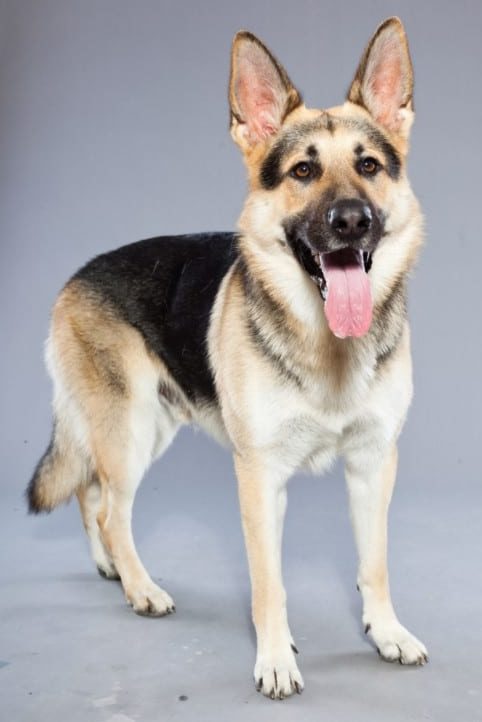
Black and silver German Shepherds and blue are some of the rarest coat colors, followed closely by gray and liver.
White German Shepherds and black and cream are also rarer than the black and tan that represent the breed.
And while no formal studies have been conducted into the statistics of unconventional colors, isabella (lilac) is understood to be the rarest German Shepherd color.
Generally, the price of a product is informed by its rareness, but because the German Shepherd demand can be informed by a range of motivations, the rareness of color doesn’t always correlate with its price.
The highest paying customers intend to show their German Shepherds at the local or state-level dog show. Since many rare colors are simultaneously faults or disqualifications by breed standards, they aren’t on the more affluent customers’ demand radar. Consequently, the price hike is not proportionate to the dog’s rareness.
Liver German Shepherds are pretty rare yet will sell for cheaper than a black and red show line. However, that’s not to say that a GSD that cannot enter a show ring is inherently cheaper.
A long-haired lilac German Shepherd (extremely rare) has no chance at a show yet might be priced higher than most show line dogs with higher odds of dog pageant success. Ultimately, demand and supply do play a role in the pricing, but the rareness doesn’t always reflect demand.
Faulty or Unaccepted Colors for Conformation
German Shepherd demand is inconsistent with their supply because the breeders deliver whenever a trait is desired by the show crowd.
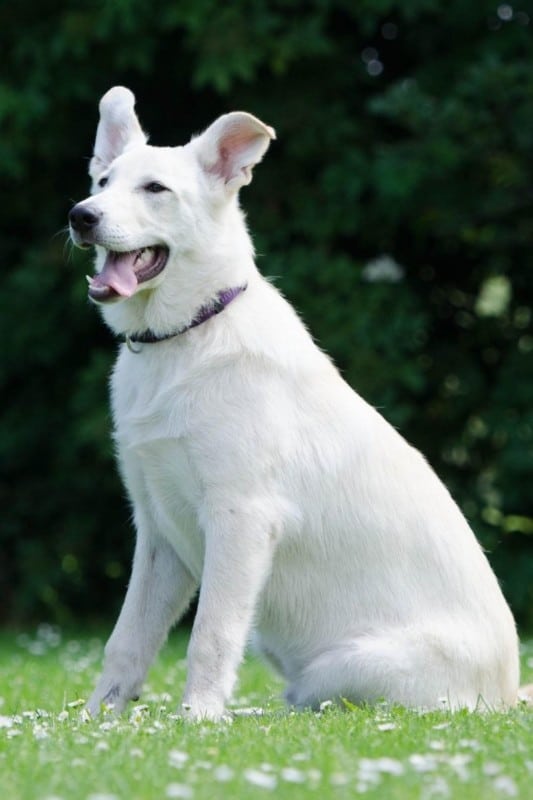
The rareness, then, is primarily a reflection of a lack of demand. When breeders try to get rid of a particular color because it is unacceptable in the show ring, it becomes rarer because of stud disqualification. Some of the unacceptable colors considered faults in this context are:
- White
- Isabella/Lilac
- Blue
- Liver
- Pale/Washed Out Colors
Some of the German Shepherds with a “fault” color belong to the working line, which means their standard price isn’t affected negatively. If you want a guard dog, the fact that the show crowd scoffs at his color won’t discourage you from buying. In such cases, the rarity of color can drive up the price because there’s no factor lowering demand.
German Shepherd Coat Patterns
Patterns and Markings of the German Shepherd
German Shepherds are rarely a single block of solid color. They often feature different colors, distributed in one of a handful of patterns. Whether the dog you want is bicolor or not, he is likely to fit in one of the following patterns.
- Solid color – This is more of a lack of pattern than a pattern. Dogs that are a solid color are usually entirely black but can also feature a different color. They might have different markings as puppies but mature into a single color look by not regrowing the different-colored fur they shed.
- Saddle – This distribution pattern looks like the German Shepherd has a saddle on his back. The color of the saddle is usually black, the darker of the bicolor arrangement.
- Blanket – When the saddle pattern is large enough to cover almost the entire back and a significant portion of the limbs, it is called a blanket pattern. German Shepherds with this pattern have contrasting fur.
- Sable – This is a color contingent pattern where tan, red, gray, silver, or blue hair is peppered across the dog’s core, back, and limbs. The other color is usually black which occurs on the tips of individual hairs producing the sable color pattern.
- Brindle – This is a rarer pattern with black color being distributed in barely noticeable stripes across the dog’s body. The other color is often lighter.
- Panda – This is a pattern that usually comes in addition to a saddle or a blanket where the dark color of the dog’s back is also distributed around his eyes, giving him a panda-like appearance.
- White Markings – These markings can scare away some people who start doubting the puppy’s viability for dog shows. However, they usually go away as the German Shepherd doesn’t regrow the lighter fur. Occasionally a dog will continue to have white markings even after reaching adulthood.
- Mask – This is a pattern often in addition to blanket or saddle, where the contrasting dark color also covers the dog’s face with lighter fur surrounding it, giving an appearance of a mask.
- Reverse-mask – This distribution gives the dog a wolf-like appearance as the lighter fur makes up the mask, and the darker fur surrounds it and even connects with the saddle or blanket. This pattern looks eerily similar to wolves, especially if it is in silver and white.
FAQs
What is The Best Way to Groom a German Shepherd’s Coat?
The best way to groom a German Shepherd’s coat is to brush them regularly with a slicker brush and an undercoat rake, paying special attention to the undercoat.
Bathing should be done as needed, but not too frequently as it can strip the coat of its natural oils. Avoid shaving or cutting the coat, and use a de-shedding tool to manage shedding.
What Kind of Supplements Can I Give My German Shepherd to Improve Their Coat Health?
Supplements such as omega fatty acids, prebiotics, and probiotics can improve a German Shepherd’s coat health. Glucosamine and chondroitin can also help protect joint cartilage and cushion the joints, which can be beneficial for German Shepherds due to their activity levels and potential health conditions.
Can I Trim My German Shepherd’s Coat?
It is generally not recommended to trim a German Shepherd’s coat, as it can affect their ability to regulate their body temperature and protect their skin from environmental elements. It is best to let their fur grow at its natural rate and manage shedding with regular brushing and grooming.
Final Thoughts
German Shepherds are big dogs with an even bigger set of categories, with many unrecognized on a breed level. Most distinctions are only visual, and if you want a dog of the correct appearance, you need to articulate your demand along the following lines.
- German Shepherd coat length – decide if you want a short, medium, or long coat German Shepherd.
- German Shepherd coat colors – figure out which colors you like and if they are considered faults by the AKC.
- German Shepherd coat color distribution – look at pictures of German Shepherds with different patterns and decide which color distribution sits right with you. Make sure to remember the standard word for the distribution.
Related Posts You May Like:


